The Planes of IL-2 1946
Article Type: Military HistoryArticle Date: January 22, 2007
by Jim "Twitch" Tittle
Rocket Attack
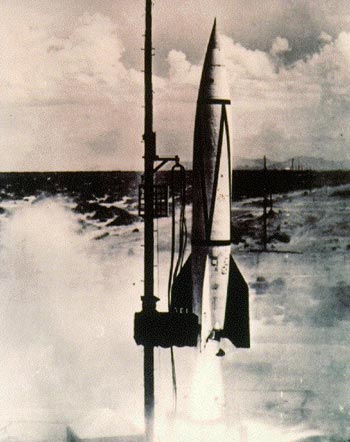 |
| V2 Rocket |
We know German rocket technology advanced during the 1930s and on through the end of the war. The main architect of the fabled V-2, Werhner von Braun, ultimately got the US to the moon based on those early rockets. But German rocket roots actually began in 1919 with the banning of possession of artillery by Germany under the post war treaties. Since rockets were not specifically detailed it was a loophole that Germany could exploit to possess some form of ballistic artillery.
Released to the public domain only in 2001, a 1922 incident and conversation with General Billy Mitchell and von Braun's teacher, Dr. Hermann Oberth plus a few others individuals came to light. Oberth predicted rocket propelled bombs and turbine engine power for aircraft. The root ideas were alive and well at this early date. Oberth published a paper in 1923 that was to so inspire Werhner von Braun. It was titled 'Die Rakete zu den Planetenraumen' (By Rocket into Planetary Space.) This was followed by a longer version (429 pages) in 1929 that was internationally regarded as a work of tremendous scientific importance. So this stuff wasn't new to the late 1930s. The "master plan" was at work for two decades before!
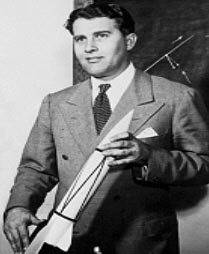 |
| Von Braun with A-4 |
The history of the first cruise missile, the V-1 and the first ballistic missile, the V-2 are written in the blood of their WW 2 victims. Original designation was 'A' for aggregate. The A-4 was the V-2. The A-1 and A-2 were developed during the time of the Weimar Republic. All the Nazis did was to later call them Vergeltungswaffen- vengeance weapons, hence the 'V' in V-2.
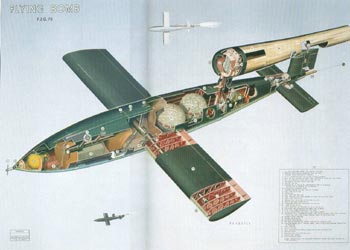 |
The V-1 |
The general knowledge is that the V-1 and V-2 had fairly limited range and were generally no serious threat to distant lands. But what about the things we hear about fantastic tech weapons capable of reaching across the ocean to the US? Most has been dismissed as impossible or fantasy. Indeed the web is littered with bizarre Nazi fairy tales from UFOs to…you name it.
It is a fact that the German nuclear bomb programs were, in the end, not close to success. Of course with Wernher Heisenberg passively sabotaging it we can only guess the outcome if a cohesive and dedicated force worked together. Along the way there were some near successes that were not recognized as such at the time.
What we must acknowledge is that a "dirty" radiation-spreading bomb could have been deployed against the Allies at almost any time along the way in the nuclear development program.
At the very beginning of Hitler's reign in 1933 he was apprised of the rocketry situation in Germany. The fact is that the full family of 'Aggregates' went from the A-1 to the projected A-12! The A-9/A-10 was a 2-stage ICBM capable of reaching the east coast of the USA. When Hitler was briefed on the long-range rockets he gave permission for development. This tells us something. Of course by 1941 ALL projects that wouldn't see fruition in a year were suspended.
But it was mid-1943 when the A-4 was given his sanction to be weaponized to the fullest by Hitler.
Of course they would have had to pass through extensive successful testing and development phases before they would be built. It was a long slow process that really took until 1945 to see fruition. The A-4 was not the culmination but only a step on the way to a true ICBM. Why he vacillated in commitment to going ahead full since 1939 is unknown. Most likely rockets fell victim his thinking in the early war years- if a project can't reach fruition in a year or so it was not needed because the conflict would be over in a couple years at most.
Most assuredly the 1-ton V-2 warhead was not cost effective for such an expensive weapon system. There are simply too many references to nuclear warheads and their destructive forces throughout the Reich for the plan to not be valid. It has been downplayed since the US Manhattan Project produced nukes and they were used against Japan. But vivid and ongoing descriptions of future nuclear damage from rockets was repeated by people like Goebbels and Speer to the point that it was obviously not a secret and was expected to be successful in the near future. The many people alluding to nuclear weapons fully expected to have them operational.
People make much of the fact that Hitler never seriously considered invading England. That he couldn't, if you will. He always admired the British and truly felt they would realize the threat that communism posed to Europe, sue for peace and join Germany in this crusade. Is anyone naïve enough to actually believe that if Hitler's goal from 1933 on was to conquer and occupy the British Isles that he wouldn't have concentrated on that singular goal?
He Didn't Like Us!There were no published anti-American quotes by Hitler. He wrote nothing of the US in Mein Kampf. So it was just a show of solidarity with Japan that he declared war on the US after Pearl Harbor, right? We must delve into Hitler's 2nd Book, as it is called, since the incomplete manuscript probably written around 1928 was discovered in 1958 but had no title. To put it concisely, he ultimately saw the USA as an enemy that must be vanquished somehow. He was still harboring resentment for the fact that the US sent troops to fight Germany in WW I. Hitler was not seething with rage against the US as he was with Jews but he believed that fundamental differences in America's policies with Germany were serious enough for the country to be considered an enemy.
There exists a bravado today that has perpetuated a myth that the German rocket attacks on England and the Low Countries were not significant. Nothing was further from the truth. The problem had to be dealt with on every level imaginable. Dealing with it cost time and resources and tied up personnel. If the tunnel escapes of 50 Allied POWs from the Luftstalags caused widespread efforts of large numbers of troops in Germany we can only imagine how many people were involved in some aspect of dealing with the incoming rockets on an ongoing basis in England alone. People were killed and their domiciles were destroyed displacing them by the tens of thousands.
To sum up at this point we must acknowledge that rocketry and jet technology was afoot in Germany since the end of WW I. Hitler decided that North America represented a threat. Key individuals in the Third Reich knew of the devastating power of nuclear weapons, described that and expected them to reach fruition. The "Aggregate" rocket weapons were not cost effective at all with conventional warheads. Speer and the rest were underwriting the high cost until atomic ones were available.
A close look at Peenemunde itself will lend credibility to the fact that it was over-built with underground facilities and over-engineered structures. When the place was built there was no idea that streams of Allied heavy bombers would one day be visitors. It was built to withstand nuclear bomb accidents though, perhaps.
A Look At The A-4 FamilyBefore the A-4 the A-1 of 1933 was never test-launched. Only two A-2 s were built in 1934. The A-3 of 1937 saw four copies that flew with internal guidance as would the A-4. The Peenemunde A-4 (V-2) was the official name. It was 46.9 feet long. The fins spanned 11.7 feet. Its girth was 5.4 feet in diameter. Full of its liquid fuel and 2,200-lb. warhead it weighed 28,229 lbs. ready to launch. Terminal speed was 3,800 MPH but range was just 190 miles after a climb to about 130,000 feet.
The A-5 was a smaller scale rocket that was test launched from He 111 bombers but could also be ground-launched.
The A-4b was a winged version tested in 1944 for data relevant to glide characteristics that were to be used in the A-9. The A-6 and A- 8 designations were for design studies of long-range rockets. The A-7 however became the final winged test vehicle for the A-9.
By adding wings to the A4 the 800 MPS of energy the rocket possessed at engine cut-off could be take advantage of in a glide attack, thus extending the range of the missile from 250 km to 550 km. Various tests of the A-4's with wings began in early 1940. These were successful, and the configuration was dubbed the A-9. A trajectory for such a missile required a boost to an apogee of 29 km followed by a stable glide at 20 km altitude at a speed of 1,250 MPS. At the end of this glide the missile would have descended to 5 km altitude and would then make a vertical dive on the target like the V-1.
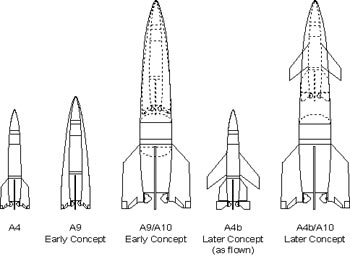 |
| Rocket Models |
The A9 would be equipped with wings with a total area of 13.5 square meters. A manned version of this boost-glide rocket-plane was also designed. It could reach a conventional airfield 600 km from the launch point in just 17 minutes. It would then land at a speed of some160 KPH. Another possibility to further extend range would be a catapult-launched A-9, using the technology developed for the V-1. This would give an additional velocity of 350 MPS extending the missile's potential range further.
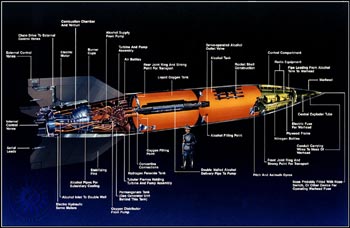 |
The A-4 |
As it was the V-1 wasn't dead yet either. In hindsight it can't be measured as very serious a threat but in October 1944 the OSS got information of a 4 U-boat contingent with orders to sail to New York at an unknown future date and launch V-1s.
That wasn't very scary in itself but what was is the fact that in the War Dept. document # 14630, not declassified till 1978, it was assumed that Germany had nuclear capability! While we now call the V-3 the super gun in France, back then the V-3 was a nuclear armed V-1 derivative. SHAEF HQ sent the alert and by December an ULTRA/MAGIC document sent to US and British authorities the plan of a blind attack on the US with "this weapon based on the principle of the explosion of nuclear particles in the atom."
There was work ongoing that made the V-1 faster (about 500-560MPH) and the Super V-1 would not be intercept-able by any Allied fighters. As it was only 2 out of 10 V-1s made it to targets.
The head of the Peenemunde facility was Major General Walter Dornberger. He described the "New York Rocket" in his book V-2 The Nazi Rocket Weapon in 1952 thusly:
"Thus the A-9 came into being. The missile was planned to reach at a height of about 20 kilometers (12 miles), a maximum speed of 4,400 kilometers per hour (2,800 miles per hour) and then go into a shallow curving glide with a peak of nearly 30 kilometers (18 miles). On arrival over the target at a height of 5 kilometers (3 miles), it was planned to dive vertically, like the" V-1, a primitive rocket-powered cruise missile, best known in World War II as "the buzz bomb. "A better plan, however, and one which greatly improved range, was to construct the A-10, weighing 87 tons and with a total propellant capacity of 62 tons, as the first step of the combined A-9/A-10. The A-9 was placed on top of the A-10. The latter had a thrust of 200 tons for 50 to 60 seconds and gave the rocket a speed of 4,400 kilometers per hour. After the exhaustion of the first stage or A-10, the A-9 would be ignited and lift out of the A-10." |
Using catapults and wings an A-9 would almost achieve 1000 kilometers in range, but the only solution for transatlantic missions was the two-stage A-9/A-10. The A10 boost stage was to have a total mass of 87 tons with 62 tons alone being propellant. The stage's 200-ton thrust motor would burn for 50 to 60 seconds, accelerating the A-9 upper stage to 1200 meters per second. The A-9 would then separate and burn its engine, reaching an apogee of 55 km followed by a drawn-out hypersonic glide in the atmosphere. The second stage would be equipped with air brakes for deceleration over the target for a parachute recovery in the water. The A-9/A-10 would reach a maximum velocity of 2,800 MPS and have a range of 4,100 km with a flight time of 35 minutes. Full-scale development was underway when further significant work on the project was stopped at the end of 1942.
| "Once we reached this stage in the blueprints," Dornberger says, "the horses fairly bolted with us. With our big rocket motors and step (multi-stage) rockets, we could build space ships which would circle the earth like moons at a height of 500 kilometers (300 miles) and at speeds of 30,000 kilometers per hour (18,000 miles per hour). Space stations and glass spheres containing the embalmed bodies of the pioneers of rocket development and space travel could be put into permanent orbits around the earth. An expedition to the moon was a popular topic, too. Then we dreamed of atomic energy, which would at last give us the necessary drive for flight into the infinity of space, to the very stars." |
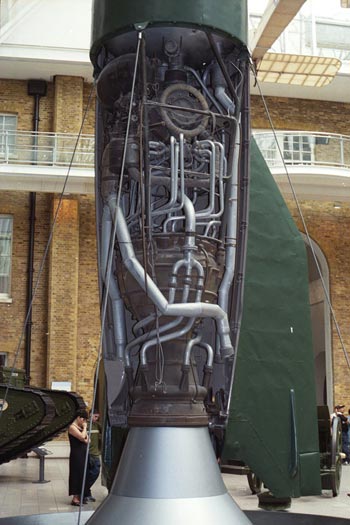 |
| V2 Motor |
The Peenemunde group drew up those blueprints during 1942-43. General Dornberger recalled off-duty brain storm sessions, in which Wernher von Braun, Willy Ley, Klaus Reidel and even Hitler's favorite aviatrix, Hannah Reisch, "chatted with such easy familiarity about outer space, the moon, the planets and what forms extraterrestrial life might take."
An Ambitious VehicleWernher von Braun envisioned his space dream in the A-11/A-12. The A-12 has been named as the designation for a true orbital launch vehicle, as sketched out at Peenemunde. It would have been a four-stage vehicle consisting of the A-9, A-10, A-11 and A-12 stages. Calculations suggest it could have placed 10 tons into low earth orbit. Of course this wasn't possible before the collapse of Germany. It would have taken a few more years. This concept was what ultimately got the US into space.
The reconstruction here is purely an estimate, assuming the A-12 stage followed the design philosophy of the A-11 drawing. The A-11 stage would have resulted in a satellite launcher. The A-12 stage resulted in a 4-stage vehicle with the A-9 being a manned orbital space shuttle. Unless development of a new engine was undertaken 50 A-10 engines would have been required in the first stage, pre-dating Von Braun's design of 1948-52
The ironic thing is that in 1942 there was a serious attempt to conceive a vehicle that would be able to reach the United States, nuclear or non-nuclear warhead notwithstanding. The Peenemunde group was not involved in type of payload. That was an entirely separate program. At a time when factions in the US were struggling to produce a fighter that could simply escort bombers from England to Berlin the Peenemunde gang was calculating rocket trajectories to the East coast via space!
After 1943 the A-9 and beyond projects were technically shelved for intensity on the A-4 but von Braun continued its research under the guise of the winged A-4b. In late 1944 work on the A-9/A-10 resumed under the code name Projekt Amerika.
Guidance systems of the time were hopelessly inaccurate at the 5,000 km range planned for the A-9/A-10. So it was decided that the A-9 would have to be piloted. After cutting off the engine at some 390 km altitude and 3,400 MPS, the winged A-9 would re-enter the atmosphere to commence a long glide to extend the range. The pilot was to be guided by radio beacons laid by U-boats in the Atlantic Ocean. After reaching the target the pilot would lock in the target in an optical sight, then eject. Death or internment as a prisoner of war would follow. There was a very slight possibility a U-boat might recover him.
Gone FissionWhile Hitler may have been crazy he wasn't stupid. The only justification for the immense investment in ballistic missiles was for the ultimate warhead- nuclear. The Germans had all sorts of vehicular scenarios for delivery too. Most were missiles and they didn't involve big 5 ton weapons like the Hiroshima bomb. Their first design was 2,200 lbs. and many other non-fission, isotopic weapons were in development or actually on the shelf. There were many sub models of the V-1 and V-2 of a specialized nature that could deliver myriad warheads of nuclear material, bio-chemical and more. Had Hitler chosen to be even more inhumane he could have ordered bio-chemical attacks with V-1s at any time since Germany had a stockpile of suitable material of that type.
Make no mistake, from the time Hitler became chancellor and was made aware of the possible future of rockets he was in favor of the research. And when scientists Otto Hahn and Friedrich Strassman created the fission of uranium U-235 in December 1938 and it was theorized that a bomb of atomic power could be created, the goal was to arm missiles with that bomb.
The Germans had the capability to deliver a radiation or dirty bomb at any time after 1942. There were plans for a Super V-1 if you will, that was capable of greater speeds than earlier versions which could just be intercepted by the fastest Allied planes. It and the V-2 could carry a 2,200 lb. warhead. Any atomic device would have had to have been reduced to this required size, simple enough for a radiation-spreading device.
The Germans had this type of fissionable device planned:
The nuclear apparatus consisted of ten layers of uranium formed into circular plates of different diameters stacked inside the top half of a sphere. The plates did not lie atop of one another but would have had spaces between them so that kerosene could flow between them. So they had alternating layers of uranium and kerosene. Kerosene was used for its excellent absorbsion of the neutrons so that the plates did not interact in an atomic manner.
They used about 551 kilograms of uranium. A tube ran vertically through the bomb's axis. A small ball of beryllium and polonium was used to release a spray of neutrons at the beginning of the fission process. The bottom half of the sphere was filled with solid ballast, probably steel or iron.
At supersonic speed the projectile pierces a building. The impact force shears the pins holding uranium plates. The sphere shatters under the pressure of its compressed kerosene load, which then ignites and spews out in all directions. The detonator cap in the nose unleashes a spray of neutrons into the uranium. If the device does not detonate in chain reaction fashion the uranium commences meltdown. Once the material bores through to the water table a mass of superheated water will arise in a colossal cloud of radioactive steam that will poison the area for decades hence.
Yes, the real German atomic weapon was a feasible reality. Ten uranium layers were to be spaced within the 2.5-foot diameter sphere so that kerosene could flow between them. Why? Kerosene absorbs neutrons very well to insulate against contact and reaction. Then once the small golf-ball-sized sphere of beryllium is fractured neutrons commence the fission process.
The meltdown scenario is a possibility since the American A-bomb functioned with a 1,000 FPS shot of collision to smash its uranium plates together and produce the chain reaction. A free falling bomb might not travel so fast.
The A-4 impacted at 3,000 FPS.
Late in the war 560 kilos of uranium oxide was shipped to Japan in the U-234 that surrendered after leaving port. That amount of uranium oxide contained about 3.5 kilos of Uranium-235. That is about 1/5th-1/3rd the amount needed to make a nuclear bomb with the yield of the Hiroshima blast. The material certainly found its way to Oakridge but there is no way of knowing specifically what device it was used in.
Revisionist dismissing of the scale of the German program attempt to prove they couldn't refine the material without the scope of a program such as Manhattan. If that were the case why would they have parted with a sizeable amount for the Japanese? If documents exist relating to how much uranium the Germans refined they will probably never be released.
The Japanese had a substantial amount already gleaned from scouring China for their nuclear research facility in North Korea. They had developed gas centrifuges to refine uranium back in the 1930s. The Germans got into that technology about 1942. The benefit was the lack of heavy water needed. Decrypts of messages point to Germany/Japan transferring this technology and material in 1943-44. When Italy capitulated in 1943 a sub with uranium oxide bound for Japan was surrendered in South Africa.
The U-234 could carry lots of cargo. Containers were built to fit in the original mine shafts forward, amidships and astern. Four cargo containers were carried topside. 240 tons of cargo were loaded for departure March 25,1945. Cargo included three crated Messershmitt Me-262 jet fighters and an ME-163 rocket-propelled fighter, Henschel HS-293 glider-bomb, extra Junkers jet engines, 10 canisters of uranium oxide, a ton of diplomatic mail, and over 3 tons of technical drawings, plus other technology (torpedo, fuses, armor piercing shells, etc.) Passengers were 9 high technical officers (one general) and civilian scientists.
The U-234 was not the first U-boat voyaging to Japan. U-219 and U-195 had delivered 12 V-2s to Japan in 1944. U-859 sunk in 1944 was carrying uranium. The U-219 was turned over to the Imperial Navy to become the I.505. The U-195 became the I.506. There were something like 98 known attempts or successful voyages to Japan so we can only imaging what goodies were sent. Certainly the uranium oxide was not the first shipment.
The US had produced only enough material for the 3 bombs- Trinity test, Fat Man and Little Boy. It would have been about 6 months needed to build another so touting a 10 city nuke tour was just a lot of propaganda though no one knew it then.
We must acknowledge that the Allies, as the victor, a purposeful campaign was, and still is waged to downplay Axis success. There are still documents classified from WW 2 that have nothing to do with American nuclear secrets. Other things have been declassified over the years. Some material declassified only in 2001 regarding the nuclear, bio, chemical weapons and other technology pursued by the Axis. There is new information still coming forth about WW 2.
It is so easy to poo-poo things and make ridiculous statements such as "they could have never done this or that." It was Allied business to counter Axis propaganda with Allied BS and to downplay Axis successes. Everyone has this picture of Wernher Heisenberg and a handful of nerds in a little lab as he passively sabotaged the whole German nuclear war effort. There were many other people dedicated to the nuclear puzzle and alternatives to a nuclear bomb but using nuclear material offensively. In short, all that most people know is what has been popularized. When obscure references are made to seemingly improbable Axis weaponry people are conditioned to reject them. It is implied that the Germans, Italians and Japanese were too inferior to outshine the Anglo-Saxon juggernaut of intelligence.
There were over 200,000 people working on various rocket programs in Germany yet we have been led to believe that one science geek was alone bearing the weight of the Reich's success or failure to develop the only warhead that would even justify the rocket program's huge expenditures.
The Rest Is HistoryWhile it's all history now it is noteworthy that the Weimar Republic continued rocket development until Hitler came to power in 1933. They made great strides that could never have been duplicated during the war years of 1939-45 alone no matter how much effort was expended. This is a mirror of what a nuclear program might have been had it begun much earlier. Had the likes of Albert Einstein explored the nuclear questions with funding during the 1920s in a program equally serious to the rocket one we must shudder to think of the results.
The study of nuclear power in Germany began far too late and was far too fragmented amongst multiple groups working blind relative to their counterparts. Had they all worked together it makes sense that the probability of success would be increased. Also the fact that had those other esteemed scientists had been working in close quarters with Wernher Heisenberg they would have recognized his reluctance to produce serious results. For example Kurt Diebner and Paul Hartek worked on uranium enrichment for a uranium-based bomb while Heisenberg tried to create sustained fission reactions and possibly a plutonium breeder reactor.
Of course the modus operandi of the Third Reich was rivalry fostered by Hitler himself. All factions and individuals involved in any undertaking or plan were in competition with peers which produced back-stabbing dramas, deceit and secrecy. The infighting between Munitions Minister Albert Speer and the SS is a good example. As Speer withdrew funds from atomic research projects the SS covertly funded them.
It is a very outside chance that given different circumstances it all would have come together with Germany possessing a nuclear bomb and a vehicle capable of delivering it to the USA. But history as we know it was often decided by the slimmest of margins. A different decision or a fortunate breakthrough within a razor's edge of variance would have produced a different outcome. It is historical fact that the US developed a nuclear bomb but it took several more years before it had a missile to deliver it. And that came from von Braun!! It's not difficult to see how a program begun several years earlier could have produced results in Germany.
Did the A-9/A-10 get into space though? An existing hazy photo shows a swept-winged A-9 on top of a cluster of rocket boosters, flames pouring out of five nozzles on the array. There is no way to place the object relative to anything for size comparison.
The October 10, 1952, edition of the Swedish newspaper Aftonbladet reported that a space rocket had been launched from an SS facility near Prague in February 1945. The vehicle described sounded like an A-9/A-10. We note this is the same area/facility that is associated with UFO-like Nazi disc tales that flood the internet today.
| "On January 8, 1945, the first version of the A-9 took off. The control failed about 30 meters (100 feet) above the firing table (launch pad)," Dornberger wrote about the Prague launches, "A few days later, we were unable to launch another missile because the alcohol tank had developed a leak. At last, on January 24 (1945), we had our first success. The rocket, climbing vertically, reached a peak height of nearly 80 kilometers (50 miles) at a maximum speed of 4,300 kilometers per hour (2,700 miles per hour)." |
Perhaps the A-9/A-10 missile is what roared into the heavens and has been convolutedly described as a saucer. We know test flights of the A-9 alone were made.
Dornberger said that von Braun was a problem solver extraordinaire. So if there was any alternate historical reality to ponder we can rest assured that von Braun would have achieved any goal laid down.
There was never any doubt that manned space travel was Wernher von Braun's life goal. The technology needed for manned flight presented many technical challenges. He realized early on that only multi-staged, liquid-propelled rockets could achieve this dream. Rockets certainly needed light-weight propellant tanks. And there still had to be a payload. Von Braun knew that liquid oxygen/liquid hydrogen was the ultimate propellant combination but also that learning how to handle liquid hydrogen would be a long-term affair.
The Advanced Projects Group planned to develop a stratospheric rocket that could travel from Europe to America in 40 minutes after the war. Then the target was orbital spaceships that could reach 8 KPS and 500 km orbital altitude. Beyond that it was orbiting space stations including an observatory in space and a space mirror. Manned expeditions to the moon were also a popular theme for research. Finally, the use of nuclear energy to achieve interstellar travel was studied by the Advanced Projects Group.
The Nazi rocket program was very costly. The same amount of Reichsmarks could have funded equipment and weapons production that would have had a more immediate positive impact on the German military. On the other hand rocket attacks against England and the Low Countries were the ultimate terror weapon. No one knew how many the Germans had. Allied resources had to be diverted to study the rocket weapons and attempt to plan defenses against them plus gather intelligence and analyze it. There was a lot unknown at the time and fear of that unknown can't be dismissed. Psychologically they were an impact on the population.
We will probably never know everything about the German rocket and nuclear programs. All the principle people are gone and even when they were here they downplayed things. Most documents on the subject were destroyed at the end of hostilities or made top secret. N one wanted proof that they'd worked on sinister Amerika rockets made to carry nuclear weapons. That might have hindered post-war job offers!
The remarkable progress that was made after Hitler gave the A-4 full support in July 1943 would have been taken much farther had funds and personnel been dedicated in late 1939 or early 1940. Thankfully, the world was better off for his indecisiveness, mind changes and his control freakiness. Otherwise it is highly likely that the A-9 would have been seen over America.
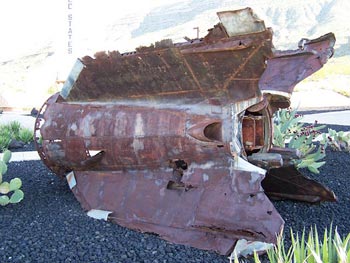 |
| Relic of the rocket program |
Dornberger, Walter
V-2 The Nazi Rocket Weapon
Viking Press, NY 1954
Ford, Brian
German Secret Weapons- Blueprint For Mars
Ballantine Books, NY 1969
Georg, Friedrich
Hitler's Miracle Weapons Vol. 1 & 2
Helion & Co., West Midlands, GB 2003 & 2005
Gunston, Bill
The Illustrated Encyclopedia of the World's Rockets & Missiles
Salamander Books Ltd, London 1979
Hitler, Adolf (edited by Gerhard L Weinberg)
Hitler's 2nd Book
Enigma Books, UK 2003
Pocock, Rowland, F.
German Guided Missiles
Arco Publishing Co., Inc, NY 1967
Simon; Leslie E.
Secret Weapons of the Third Reich
WE Inc., Old Greenwich, CT 1947
Simon, Leslie E.
German Scientific Establishments Report P.B. 19849
Mapleton House Publications, NY 1947
Von Braun, Wernher, & Ley, Willy,
The Conquest of Space
Espasa-calpe, SA, Madrid, 1966.
As an author of war and air combat related writings I have had the fortune to meet and discuss such things with a large number of aces and others from the US, Great Britain, Germany, Russia and a couple from Japan. Beginning in the early 1980s I was a member of various organizations that brought aces to the US from the other countries for air combat discussion symposiums and conventions. I found it quite easy to get questions answered along with lengthy explanations of combat missions for my tape recorder. Fighter pilots love to talk! Fortunately I have talked to the likes of Adolf Galland, Johnnie Johnson, Gabby Gabreski and Asrenii Vorozheykin.
This comes from a life long interest in World War II aircraft and the pilots that flew them. My own father earned his wings at the end of the war and was just getting into P-51s when the conflict ended. I obtained my first books on the subject in the late 1950s as a kid and built up a library of hundreds of books since.
I draw my subject matter from the men that flew the planes and my collection of books.
